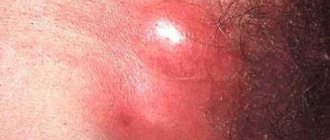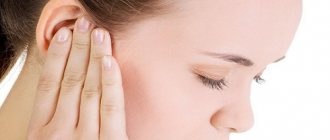To make an appointment with a doctor
Calling a pediatrician to your home
Our doctors
Our prices
November 26, 2022
A boil in a child is not only an unpleasant occurrence, but also a rather dangerous disease. The appearance of boils indicates a deterioration in the general physical condition of the child. In addition, lack of timely medical care can lead to serious complications. That is why and for a number of other reasons, a boil in a child requires close attention and a responsible attitude of parents. Self-treatment of boils in children is excluded, since the effectiveness of the measures taken directly depends on the accuracy of the diagnosis. Not all medical techniques and methods can be used to treat children. Contacting a pediatrician will help you avoid many problems and complications.
Reasons for appearance
The reasons for the appearance of boils on the body in children are very different. Doctors identify several common causes of this pathology. In order for boils to occur in a child, the reasons may be as follows:
- metabolic disorders;
- endocrine disorders;
- frequent colds and ARVI;
- weakened immunity;
- malnutrition;
- violation of personal hygiene rules;
- lack of fresh air;
- overheating or hypothermia.
Doctors divide the causes into external and internal. External reasons include:
- untreated wounds or cuts on the body;
- dirt on hands and body;
- allergic reactions with rashes;
- clogged pores due to excessive sweating.
In order to avoid the appearance of boils for external reasons, it is enough to maintain hygiene and treat scratches in a timely manner.
The answer to the question of why a child has boils is more difficult to give if the reasons are internal. Internal reasons include:
- low hemoglobin level;
- frequent stress and problems with the nervous system;
- metabolic disorders;
- weakened immunity;
- frequent illnesses (for example, a boil on a child’s abdomen may appear after a serious illness);
- diseases of the endocrine system, in particular diabetes;
- mental or physical fatigue.
Boils can occur in a child, the causes of which are very different, and can occur at any time, regardless of the external temperature and time of year. Boils can also be caused by a lack of vitamins, skin damage from friction, diseases of the digestive system, and frequent hypothermia.
Experienced doctors at the Pediatric Department of JSC Medicine (academician Roitberg’s clinic) in Moscow will help you accurately determine the cause of the disease. Our clinic’s specialists use certified safe medications and effective technologies, which is one of the conditions for the complete recovery of young patients.
What diseases cause acne on a child's bottom?
A number of infectious diseases have a rash as one of their symptoms. This rash can also be localized on the skin of the buttocks.
It does not always appear here at the very beginning of the disease, but parents still need to know what diseases they are at risk of encountering:
- Roseola, or three-day fever. This infection is manifested by a sharp increase in temperature, which lasts for 3 days. After its reduction, pink-red pimples appear on the body;
- scarlet fever. It appears as small red rashes, first in the upper part of the body, and only then on the butt. The appearance of the rash is preceded by a sore throat and an increase in temperature to very high levels;
- measles. The rashes associated with this disease are large and red. They can merge with each other. Associated symptoms are lacrimation and fever;
- rubella. The difference from measles is that the rash that appears is small, its color is rather pink and it is not prone to merging with each other;
Photo: watery rash with chickenpox
chickenpox. It appears as a rash in the form of transparent blisters. Their contents gradually become cloudy and each element turns into a crust. The temperature decreases along with the cessation of new rashes.
To treat them, it is necessary to call a doctor at home, as these infections are quickly transmitted by airborne droplets.
Symptoms
The most obvious symptom is the appearance of an area of inflammation with purulent contents. Symptoms depend on several factors, including the location of the boil:
- a boil on a child’s hand interferes with movements and can lead to the formation of a wound;
- You can notice a boil on a child’s head while washing his hair or while combing his hair;
- a boil on a child’s lip is visually noticeable and interferes with speaking and eating;
- a boil on the child’s bottom makes it difficult to sit;
- a boil on a child’s face is visually noticeable and can cause swelling;
- a boil in the child’s nose interferes with breathing and is painful;
- a boil in a child’s ear can cause ear pain and hearing impairment;
- a boil on a child’s knee complicates movement;
- A boil on a child’s neck can cause enlarged lymph nodes.
Common symptoms of a boil are:
- general malaise;
- painful sensations in the area where the boil is located;
- inflammation of the lymph nodes;
- headache;
- intoxication, nausea, vomiting;
- lack of appetite, drowsiness;
- dizziness.
In order for the elimination of pathology to be effective, it is necessary to accurately determine the cause of the boil. Only a doctor can accurately indicate the cause after a thorough examination, so the only correct decision is to contact a pediatrician. The pediatric department of JSC "Medicine" (academician Roitberg's clinic) in Moscow offers the services of qualified pediatricians with considerable experience in the diagnosis and treatment of childhood diseases.
If symptoms appear, you should immediately consult a doctor. Independent use of lotions, ointments and traditional medicine is strictly not recommended, especially squeezing pus out of a boil.
Which doctor should I contact?
Diagnosis of boils, provided they are superficial, is not difficult. It is much more difficult to correctly determine the cause of purulent inflammation. A thorough examination is carried out in the following cases:
- presence of diabetes mellitus;
- complications caused by pathology;
- when the boil is located internally (in the ear, nose).
The diagnosis of boils and treatment of pathology at the Pediatric Department of JSC "Medicine" (clinic of Academician Roitberg) in Moscow is carried out by pediatricians, who, based on the results of the examination, can refer the little patient to a dermatologist or other specialist.
When conducting a comprehensive examination, the doctor can give the patient a direction:
- for a blood test;
- for bacterial inoculation from the skin;
- for immunodiagnostics;
- for a complete blood test.
You should urgently contact the pediatric department of JSC “Medicine” (clinic of Academician Roitberg) if:
- the boil is located on the child’s face or in the spine;
- the child feels unwell, the temperature has risen;
- When the size of the boil is from 3 to 10 cm, the abscess does not burst.
Types of acne
There are several types of acne that can occur on the buttocks:
- Zhiroviki. These are white and yellow subcutaneous formations, not burdened by a purulent process.
- Papules. Dense reddish protruding nodules without signs of suppuration.
- Pustules. These are purulent acne.
Acne can also be localized, isolated, or diffuse—when the rash spreads over a large surface of the skin. Deep purulent pustules can become complicated and become boils. Superficial acne is rarely complicated by underlying inflammatory processes.
How to distinguish from a disease?
It is worth noting that acne and blisters on the butt can also appear due to certain diseases:
- Herpetic infection. The area of the buttocks, anus, and genitals is usually affected by the herpes virus type 2. Genital herpes appears as a small red rash with pronounced blisters filled not with pus, but with serous fluid. This infectious rash itches, itches, and causes severe pain to the child.
- Allergic reaction. With diaper dermatitis, little boys and girls may develop pimples under the diaper. They are caused by exposure to chemicals found in urine and feces. With other types of allergic dermatitis, the pimples will spread to other parts of the body, not just limited to the buttocks. An allergic rash differs from acne in that it does not have purulent “heads”; it looks like large red spots consisting of small red pimples without visible filling.
- Viral infectious disease. With chickenpox, roseola and other childhood diseases that manifest as skin rashes, the rash has a large area of distribution; not a single virus affects only the baby’s bottom. Other symptoms of the disease are also necessarily present - nausea, fever, muscle pain, respiratory manifestations - runny nose or cough.
- Avitaminosis. With a chronic lack of vitamins and microelements necessary for the normal growth and development of a child, pimples can appear in various parts of the body, the butt is no exception. This rash can be quite painful and is often complicated by a bacterial infection, which manifests itself in the gradual suppuration of papules and their transformation into pustules.
Danger of boils
Failure to see a doctor in a timely manner can lead to dire consequences, since this pathology belongs to the category of dangerous diseases:
- a boil on a child’s head can cause meningitis;
- a boil on a child’s lip can cause inflammation of the nerves of the nasolabial triangle;
- a boil on the child’s bottom makes it difficult to sit;
- a boil on a child’s face can lead to meningitis;
- a boil in a child’s nose can cause inflammation of the respiratory system;
- a boil in a child’s ear can cause inflammation of the hearing organ;
- A boil on a child’s neck can lead to inflammation of the lymph nodes and severe intoxication.
In the absence of timely medical care, a carbuncle, which is a collection of boils, may develop. Possible consequences are also:
- infection of the deep layers of skin tissue;
- scar formation after healing;
- sepsis.
The appearance of multiple boils causes discomfort in the child, increased temperature, and deterioration of well-being.
The consequences of the formation of a boil can be prevented if you promptly contact the pediatric department of JSC "Medicine" (clinic of Academician Roitberg), which offers the services of qualified experienced specialists in various fields of medicine.
Our clinic is located in the center of Moscow at the address: 2nd Tverskoy-Yamskaya lane, 10, a five-minute walk from the Mayakovskaya metro station.
Pathogenesis and stages of development
During the development process, the boil goes through three successive stages:
- initial (infiltration): the inflammatory process begins at the mouth of the follicle and gradually spreads;
- necrotic (maturation): inflammation engulfs the entire cavity of the follicle, causing necrosis and purulent melting of tissue; the process lasts from several days to 2 weeks and ends with a rupture of the skin over the center of the boil;
- healing stage: after the pus has drained and the cavity of the lesion has been cleaned, it gradually scars with the formation of a scar.
Treatment
If a boil appears in a child, treatment should be started immediately. Based on the examination and examination of a small patient and taking an anamnesis, the doctor will draw up an effective treatment program. Consultation with a pediatrician is required if internal boils are present. If a boil on a child’s leg does not cause any particular concern, then treatment can be medicinal, using antiseptic and painkillers.
Modern techniques include the use of local ultraviolet irradiation. The pediatrician of JSC "Medicine" (clinic of Academician Roitberg) can also prescribe physical therapy (UHF therapy, electrophoresis with antimicrobial drugs).
Drug treatment
When a boil is diagnosed in children, treatment is prescribed taking into account the stage of the disease and the level of immunity. Antibiotics may be prescribed under the following conditions:
- a carbuncle has formed;
- high temperature rose;
- a boil has formed on the face;
- the infection has penetrated into the deep layers of the skin;
- there is severe pain.
Medicines are prescribed exclusively by a doctor based on the results of the examination.
Surgery
Surgical treatment of pathology is rarely used under local anesthesia. If the boil in children, the treatment of which is selected individually, does not rupture on its own, the surgeon pierces it with a sterile needle or makes a small incision through which the pus is removed.
Folk remedies
This is especially true for prickly heat and diaper dermatitis.
Photo: decoctions of medicinal herbs can be added to a bathtub
Decoctions of medicinal herbs help with them - chamomile, string, sage, birch buds. They can be added to baths, used for rubbing and compresses.
Photo: for allergies, it is useful to use a decoction of bay leaves
For allergic rashes, an infusion of bay leaves will provide good help. Place a dozen leaves in a small saucepan, add 1 liter of water and boil over low heat for 15-20 minutes. Then cover with a lid and let cool. You can wipe the areas with rashes with this infusion several times a day, and also add it to your evening bath.
Photo: a bath with sea salt is useful for rashes in children over two years old
A sea salt solution has a good effect on damaged skin. Take 5 tablespoons of salt per liter of warm water and dissolve it. Sea salt can be used for compresses, rubbing, and baths. It is used in children over 2 years of age.
Consultations with other specialists
Contacting specialists in various fields of medicine is necessary, since boils of bacterial origin (staphylococcus) can provoke:
- formation of a focus of chronic infection (sinusitis, sinusitis, tonsillitis);
- diseases and pathologies of the gastrointestinal tract (cholecystitis, dysbacteriosis, etc.).
The formation of boils may indicate a urinary tract infection, iron deficiency anemia, immune diseases, or the presence of a latent infection (herpes, cytomegalovirus infection).
Skin care
In order not to worsen the situation, you need to visit your local pediatrician. Most often, the rash goes away quickly if you carefully follow the rules of care, which are as follows:
- daily bathing without the use of gels and shampoos;
- systematic air baths;
- use of drying or moisturizing products, depending on skin type;
- gradual introduction of new products;
- thoroughly rinsing clothes;
- timely change of diapers and underwear.
If such actions do not help, the doctor may prescribe antifungal and antimicrobial drugs, as well as medications to relieve inflammation and itching.
Delicate skin is susceptible to various rashes, among the most common:
- Diaper dermatitis. Inflammation occurs at the point of contact with a gauze or disposable diaper, from chafing, humidity and lack of air baths. In addition to the rash, it is characterized by flaky or weeping areas.
- An allergic reaction occurs due to the use of unsuitable diapers, laundry detergents, wet wipes, creams and shampoos, and a reaction to food allergens in the diet or breast milk is also possible. In this case, any location is possible. Intolerance to a particular food product most often manifests itself in inflammation around the anus.
- Candidal dermatitis has a fungal cause and appears most often under the diaper. The bright red rash may then spread to the legs, stomach, or back.
- Miliaria consists of multiple small pink pimples.
How to make an appointment with a doctor
The pediatric department of JSC "Medicine" (clinic of academician Roitberg) in Moscow offers European-level services for the diagnosis, treatment and prevention of boils in children. To receive highly qualified medical care, you must make an appointment with a pediatrician who will conduct an examination and comprehensive medical examination of the child. If necessary, the pediatrician will consult with or refer other specialists.
To make an appointment with a specialist in the pediatric department of JSC "Medicine" (clinic of academician Roitberg), use one of the following methods:
- quick registration form on the website;
- by telephone 24/7;
- using a mobile application.
Our clinic is located in the center of Moscow at the address: 2nd Tverskoy-Yamskaya lane, 10, a five-minute walk from the Mayakovskaya metro station, as well as not far from the Belorusskaya, Tverskaya, Chekhovskaya and Novoslobodskaya metro stations.
Types of acne in children on the buttocks
Depending on the type and appearance of acne, you can determine the cause of its appearance.
Reds
If red pimples appear in a child, they are diagnosed with:
- diaper dermatitis;
- heat rash;
- allergies.
In order to distinguish the cause of the rash, you should remember the main differences between the diseases.
- Diaper dermatitis is characterized by a rash of small pimples on various parts of the body. The red spots may have a watery content that turns into a crust over time. Dermatitis occurs due to improper hygiene and greatly worries the child. Because of the burning sensation, the baby becomes restless and often cries;
- with prickly heat, pimples are located on different parts of the body, without touching each other and without inflaming the skin;
- the allergy manifests itself immediately throughout the entire buttock area. After a few days, the pimples dry out and the skin begins to peel. If rashes are not treated promptly, wounds and cracks may form, which cause the development of bacteria.
Red pimples appear as a result of the development of infectious diseases:
- measles;
- rubella;
- chickenpox.
It should be remembered that during infections, rashes on the buttocks appear last.
White
White pimples rarely contain pus or other substances, so they do not cause inflammation.
They appear as a result:
- poor hygiene;
- incorrectly selected clothes;
- hypothermia.
Such rashes do not threaten the child’s life and usually go away on their own. Parents should be alerted to a rash that does not go away within 2 weeks.
Purulent
Purulent pimples are easy to diagnose due to their white, yellow or green head. Often a rash indicates inflammation.
Such rashes should alert parents, since the appearance of pus indicates the presence of staphylococcus
In this case, it is important to start treatment on time, otherwise the infection may penetrate deep into the skin and blood
Under no circumstances should pustules be crushed.
Watery
A watery rash often occurs in infants and is caused by staphylococcus or streptococcus bacteria.
The disease occurs in several stages:
- red spots appear, which after a few days turn into a bubble with transparent contents;
- The liquid turns yellow over time and turns into pus.
Watery pimples require immediate treatment. In some cases, bubbles may indicate the presence of dermatitis or allergies. When you have chickenpox, the rash spreads throughout the body from top to bottom.










